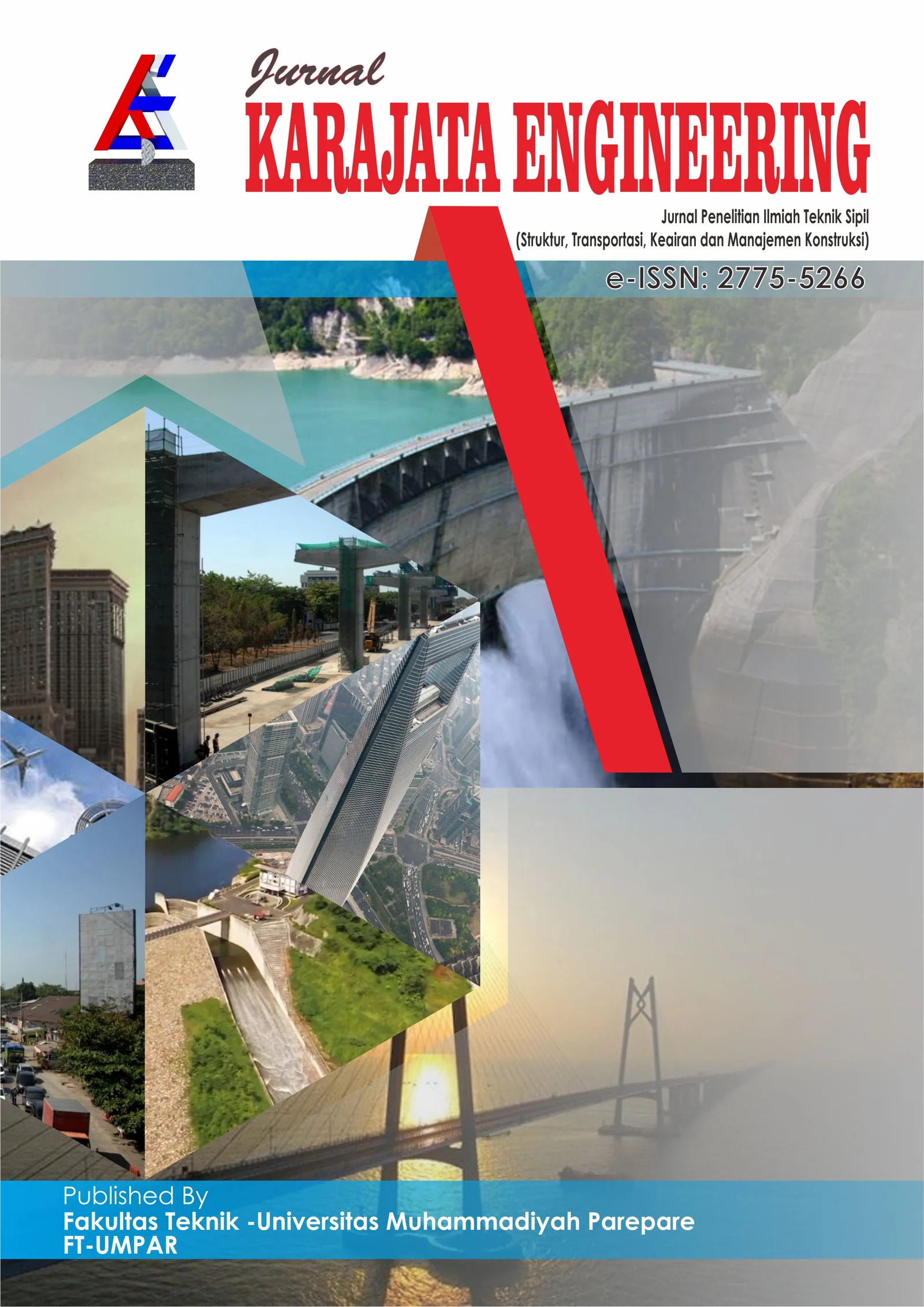Pemetaan Zona Rawan Banjir Berbasis Skoring dan Pembobotan di Kecamatan Balusu, Kabupaten Barru
Abstract
Balusu District is one of the areas in Barru Regency that has geographical characteristics that are prone to flooding. Topographically, this district has lowlands that tend to be prone to flooding during the rainy season. The purpose of this study was to determine the most dominant factors that causing flooding and to map the area of flood-prone areas in Balusu District, Barru Regency. The method used in this study was to use the scoring and weighting method. The parameters of this study namely rainfall, land height, slope, soil type and land use will later be assessed by giving weights and classification values to each and then processed using the ArcGIS software. The results obtained from this study are the most dominant factors and causes of flood vulnerability in Balusu District are land elevation and high rainfall and the distribution of flood-prone areas in Balusu District is 42.68% of the total area of Balusu District, which is 104.82 km².
References
Anas Sudijono. (2007). Pengantar Evaluasi Pendidikan. Jakarta: Grafindo Persada.
Basuki, K. (2019). Studi Pemetaan Daerah Rawan Banjir Dengan Metode Skoring Dan Pembobotan Pada Daerah Kota Tarakan. Jurnal Online Internasional & Nasional 53(9), 1689-1699.
Darmawan, K., Hani’ah, H., & Suprayogi, A. (2017). Analisis Kerawanan Banjir di Kabupaten Sampang Menggunakan Metode Overlay Dengan Scoring Berbasis Sistem Informasi Geografis. Jurnal Geodesi Undip, 6(1), 31-40.
Kamiana, I. M, Wicaksono, A., dan Nomeritae. (2024). Simulasi Pemanenan Hujan dan Pengaruhnya terhadap Debit Drainase Primer di Jalan Pangeran Samudera, Palangka Raya. Jurnal Karajata Engineering, 4(2), 103-113.
Matondang, J. P., Kahar, S., I., & Sasmito, B. (2013). Zonasi Daerah Rentan Banjir Dengan Pemanfaatan Sistem Informasi Geografis. Jurnal Teknik Geodesi Unversitas Diponegoro, 2(3), 103-113.
Nurdiawan, O., Putri, H., Studi, P., & Informasi, T. (2018). Pemetaan daerah rawan banjir berbasis sistem informasi geografis dalam upaya mengoptimalkan langkah antisipasi bencana. Jurnal Infotech, 4(2), 1-9.
Nuryanti, N., Tanesib, J. L., & Warsito, A. (2018). Pemetaan Daerah Rawan Banjir Dengan Penginderaan Jauh Dan Sistem Informasi Geografis di Kecamatan Kupang Timur Kabupaten Kupang Provinsi Nusa Tenggara Timur. Jurnal Fisika : Fisika Sains dan Aplikasinya, 3(1), 73–79.
Rendra, R. A., Suhartanto, E., & Andawayanti, U. (2024). Analisis Kerawanan Banjir Berbasis Sistem Informasi Geografis Sebagai Upaya Mitigasi Pada DAS Kedunggaleng Kabupaten Probolinggo. Jurnal Teknologi Dan Rekayasa Sumber Daya Air, 4(2), 1372–1385.
Rifandi, A., Putra, M. S., Mahmuddin, & Agusalim, M. (2024). Analisis Tingkat Kerawanan Banjir di Kabupaten Wajo Berbasis Sistem Informasi Geografis (SIG). Arus Jurnal Sains Dan Teknologi, 2(1), 190–199.
Riyanto, I., Rizkinia, M., Arief, R., & Sudiana, D. (2022). Three Dimensional Convolutional Neural Network on Multi-Temporal Synthetic Aperture Radar Images for Urban Flood Potential Mapping in Jakarta. Applied Sciences, 12(3), 1-19.
Saputra, A. K., Santoso, D. H., & Yudono, A. R. A. (2020). Zonasi Tingkat Kerawanan Banjir Pada Ruas Bekas Sungai Di Kabupaten Sukoharjo. Jurnal Geografi, 12(1), 32-38.
Septian, A., Elvarani, A. Y., Putri, A. S., Maulia, I., Damayanti, L., Pahlevi, M. Z., & Aswad, F. H. (2020). Identifikasi Zona Potensi Banjir Berbasis Sistem Informasi Geografis Menggunakan Metode Overlay dengan Scoring di Kabupaten Agam, Sumatera Barat. Jurnal Geosains Dan Remote Sensing, 1(1), 11-22.
Suhardiman. (2012). Zonasi Tingkat Kerawanan Banjir dengan Sistem Informasi Geografis Pada Sub DAS Walahane Hilir. Skripsi. Makassar: Universitas Hassanudin Makassar.
Widiasih, L. P., I Jayantara, G. N. Y., & Wisnawa, I. G. Y. (2022). Pemetaan Tingkat Kerawanan Banjir Di Kecamatan Sukasada Kabupaten Buleleng Provinsi Bali. Jurnal ENMAP (Environment and Mapping), 3(1), 45–55.
Wisnawa, I. G. Y., Jayantara, I. G. N. Y., & Putra, D. G. D. (2021). Pemetaan Lokasi Rawan Banjir Berbasis Sistem Informasi Geografis Di Kecamatan Denpasar Barat. Jurnal ENMAP (Environment and Mapping), 2(2), 51–61.




.png)


.png)








